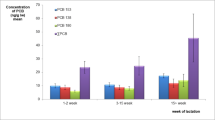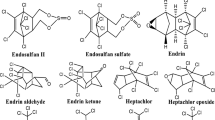Abstract
Exposure to pesticides in the environment is sensitively indicated by the concentration of these chemicals in human milk. However, to the best of our knowledge, detection methods in human milk for the relatively new class of pesticides, neonicotinoids, are yet to be validated. We developed a method of detection of neonicotinoids in human milk, together with two other classes of pesticides, pyrethroids and organochlorines. Neonicotinoids and pyrethroids are emerging pesticides that are replacing older and more persistent chemicals such as organochlorines. We optimized a procedure for extraction of these chemicals from whole milk and report our solutions to the problems of interference by co-extracted substances. The clean-up method was optimized using a minimum amount of PSA (50 mg) and MgSO4 (150 mg). This was followed by GC–MS/MS analysis (for organochlorines and pyrethroids) and LC–MS/MS (for neonicotinoids). The method was validated following SANTE/11945/2015 guidelines at concentrations 10, 20 and 100 ng g−1. Limits of quantification were obtained at ≤ 2 ng g−1 for all pesticides and lowest validated level were 10 ng g−1, with measurement uncertainty between 0.47 and 2.6 ng g−1. Average recovery ranged from 84 to 102% and for most compounds was found to be more satisfactory than the original QuEChERS, AOAC 2007.01 acetate buffer method and modified QuEChERS methods. The relative standard deviation was less than 16%. The method was successfully utilized for the analysis of human milk samples from Nadia, West Bengal and was found positive for organochlorines and negative for neonicotinoids and pyrethroids.






Similar content being viewed by others
References
WHO (2009) Biomonitoring of human milk for persistent organic pollutants (POPs). http://www.who.int/foodsafety/chem/pops_biomonitoring/en/. Accessed 15 Jan 2017
Çok I, Mazmanci B, Mazmanci MA, Turgut C, Henkelmann B, Schramm KW (2012) Analysis of human milk to assess exposure to PAHs, PCBs and organochlorine pesticides in the vicinity Mediterranean city Mersin, Turkey. Environ Int 40:63–69
Wang DC, Yu P, Zhang Y, Cui Y, Sun CH (2008) The determination of persistent organic pollutants (POPs) in the colostrums of women in preterm labor. Clin Chim Acta 397(1):18–21
Seccia S, Fidente P, Montesano D, Morrica P (2008) Determination of neonicotinoid insecticides residues in bovine milk samples by solid-phase extraction clean-up and liquid chromatography with diode-array detection. J Chromatogr A 1214(1):115–120
Jeong IS, Kwak BM, Ahn JH, Jeong SH (2012) Determination of pesticide residues in milk using a QuEChERS-based method developed by response surface methodology. Food Chem 133(2):473–481
Luzardo OP, Ruiz-Suárez N, Almeida-González M, Henríquez-Hernández LA, Zumbado M, Boada LD (2013) Multi-residue method for the determination of 57 persistent organic pollutants in human milk and colostrum using a QuEChERS-based extraction procedure. Anal Bioanal Chem 405(29):9523–9536
Aguilera-Luiz MM, Plaza-Bolaños P, Romero-González R, Vidal JM, Frenich AG (2011) Comparison of the efficiency of different extraction methods for the simultaneous determination of mycotoxins and pesticides in milk samples by ultra high-performance liquid chromatography-tandem mass spectrometry. Anal Bioanal Chem 399(8):2863–2875
CIBRC (2017) CIBRC (Central Insecticide Board and Registration Committee) Pesticides Registered under section 9(3) of the Insecticides Act, 1968 for use in the Country. http://cibrc.nic.in. Accessed 10 Oct 2017
Kamel A, Qian Y, Kolbe E, Stafford C (2010) Development and validation of a multiresidue method for the determination of neonicotinoid and macrocyclic lactone pesticide residues in milk, fruits, and vegetables by ultra-performance liquid chromatography/MS/MS. J AOAC Int 93(2):389–399
Gao YL, Sun P (2017) Determination of five pyrethroid pesticides residue in liquid milk by gas chromatography using multi-walled carbon nanotubes as dispersion solid phase extraction sorbent. Acta Chromatogr 1508:1–6
Dallegrave A, Pizzolato TM, Barreto F, Eljarrat E, Barceló D (2016) Methodology for trace analysis of 17 pyrethroids and chlorpyrifos in foodstuff by gas chromatography–tandem mass spectrometry. Anal Bioanal Chem 408(27):7689–7697
Khay S, Abd El-Aty AM, Choi JH, Shin EH, Shin HC, Kim JS, Shim JH (2009) Simultaneous determination of pyrethroids from pesticide residues in porcine muscle and pasteurized milk using GC. J Sep Sci 32(2):244–251
Anastassiades M, Lehotay SJ, Štajnbaher D, Schenck FJ (2003) Fast and easy multiresidue method employing acetonitrile extraction/partitioning and “dispersive solid-phase extraction” for the determination of pesticide residues in produce. J AOAC Int 86(2):412–431
Anastassiades M, Maštovská K, Lehotay SJ (2003) Evaluation of analyte protectants to improve gas chromatographic analysis of pesticides. J Chromatogr A 1015(1):163–184
Kunisue T, Someya M, Kayama F, Jin Y, Tanabe S (2004) Persistent organochlorines in human breast milk collected from primiparae in Dalian and Shenyang, China. Environ Pollut 131(3):381–392
Subramanian A, Ohtake M, Kunisue T, Tanabe S (2007) High levels of organochlorines in mothers’ milk from Chennai (Madras) city, India. Chemosphere 68(5):928–939
Someya M, Ohtake M, Kunisue T, Subramanian A, Takahashi S, Chakraborty P, Tanabe S (2010) Persistent organic pollutants in breast milk of mothers residing around an open dumping site in Kolkata, India: specific dioxin-like PCB levels and fish as a potential source. Environ Int 36(1):27–35
Anda EE, Nieboer E, Dudarev AA, Sandanger TM, Odland JØ (2007) Intra-and intercompartmental associations between levels of organochlorines in maternal plasma, cord plasma and breast milk, and lead and cadmium in whole blood, for indigenous peoples of Chukotka, Russia. J Environ Monit 9(8):884–893
Bergkvist C, Aune M, Nilsson I, Sandanger TM, Hamadani JD, Tofail F, Vahter M (2012) Occurrence and levels of organochlorine compounds in human breast milk in Bangladesh. Chemosphere 88(7):784–790
Trunnelle KJ, Bennett DH, Tulve NS, Clifton MS, Davis MD, Calafat AM, Hertz-Picciotto I (2014) Urinary pyrethroid and chlorpyrifos metabolite concentrations in Northern California families and their relationship to indoor residential insecticide levels, part of the study of use of products and exposure related behavior (SUPERB). Environ Sci Technol 48(3):1931–1939
Breivik K, Sweetman A, Pacyna JM, Jones KC (2002) Towards a global historical emission inventory for selected PCB congeners—a mass balance approach: 2. Emiss Sci Total Environ 290(1):199–224
Saillenfait AM, Ndiaye D, Sabaté JP (2015) Pyrethroids: exposure and health effects—an update. Int J Hyg Environ Health 218(3):281–292
Whitehorn PR, O’Connor S, Wackers FL, Goulson D (2012) Neonicotinoid pesticide reduces bumble bee colony growth and queen production. Science 336(6079):351–352
Douglas MR, Rohr JR, Tooker JF (2015) EDITOR’S CHOICE: neonicotinoid insecticide travels through a soil food chain, disrupting biological control of non-target pests and decreasing soya bean yield. J Appl Ecol 52(1):250–260
Corcellas C, Feo ML, Torres JP, Malm O, Ocampo-Duque W, Eljarrat E, Barceló D (2012) Pyrethroids in human breast milk: occurrence and nursing daily intake estimation. Environ Int 47:17–22
Kuivila KM, Hladik ML, Ingersoll CG, Kemble NE, Moran PW, Calhoun DL, Gilliom RJ (2012) Occurrence and potential sources of pyrethroid insecticides in stream sediments from seven US metropolitan areas. Environ Sci Technol 46(8):4297–4303
Nizzetto L, Macleod M, Borgå K, Cabrerizo A, Dachs J, Guardo AD, Ludwig B (2010) Past, present, and future controls on levels of persistent organic pollutants in the global environment. Environ Sci Technol 44(17):6526–6531
Evenset A, Carroll J, Christensen GN, Kallenborn R, Gregor D, Gabrielsen GW (2007) Seabird guano is an efficient conveyer of persistent organic pollutants (POPs) to Arctic lake ecosystems. Environ Sci Technol 41(4):1173–1179
Lehotay SJ, Maštovská K, Lightfield AR (2005) Use of buffering and other means to improve results of problematic pesticides in a fast and easy method for residue analysis of fruits and vegetables. J AOAC Int 88(2):615–629
Lehotay SJ, Tully J, Garca AV, Contreras M, Mol H, Heinke V, Poulsen ME (2007) Determination of pesticide residues in foods by acetonitrile extraction and partitioning with magnesium sulfate: collaborative study. J AOAC Int 90(2):485–520
Madureira FD, da Silva Oliveira FA, de Souza WR, Pontelo AP, de Oliveira MLG, Silva G (2012) A multi-residue method for the determination of 90 pesticides in matrices with a high water content by LC–MS/MS without clean-up. Food Addit Contam Part A 29(4):665–678
de Oliveira MLG, Madureira FD, Aurélio F, Pontelo AP, Silva G, Oliveira R, Paes C (2012) A multi-residue method for the determination of pesticides in high water content matrices by gas chromatography–single quadrupole mass spectrometry with electron ionisation (EI-GC/MS). Food Addit Contam Part A 29(4):657–664
Carneiro RP, Oliveira FA, Madureira FD, Silva G, de Souza WR, Lopes RP (2013) Development and method validation for determination of 128 pesticides in bananas by modified QuEChERS and UHPLC–MS/MS analysis. Food Control 33(2):413–423
Ellison SL, Rosslein M, Williams A (eds) (2012) Eurachem/CITAC guide: quantifying uncertainty in analytical measurement. 3rd edn. ISBN 978-0-948926-30-3. http://www.eurachem.org. Accessed 16 Oct 2017
Devanathan G, Subramanian A, Someya M, Sudaryanto A, Isobe T, Takahashi S, Tanabe S (2009) Persistent organochlorines in human breast milk from major metropolitan cities in India. Environ Pollut 157(1):148–154
Lacayo Romero ML, Dorea JG, Cruz Granja AC (2000) Concentrations of organochlorine pesticides in milk of Nicaraguan mothers. Arch Environ Health Int J 55(4):274–278
Sharma A, Gill JPS, Bedi JS, Pooni PA (2014) Monitoring of pesticide residues in human breast milk from Punjab, India and its correlation with health associated parameters. Bull Environ Contam Toxicol 93(4):465–471
Aysal P, Ambrus A, Lehotay SJ, Cannavan A (2007) Validation of an efficient method for the determination of pesticide residues in fruits and vegetables using ethyl acetate for extraction. J Environ Sci Health Part B 42(5):481–490
Banerjee K, Oulkar DP, Dasgupta S, Patil SB, Patil SH, Savant R, Adsule PG (2007) Validation and uncertainty analysis of a multi-residue method for pesticides in grapes using ethyl acetate extraction and liquid chromatography–tandem mass spectrometry. J Chromatogr A 1173(1):98–109
SANTE/11945/2015 (2016) Guidance document on analytical quality control and method validation procedures for pesticide residues analysis in food and feed. European Commission Health and Consumer Protection Directorate General. https://ec.europa.eu/food/sites/food/files/plant/docs/pesticides_mrl_guidelines_wrkdoc_11945.pdf. Accessed 11 Oct 2017
Acknowledgements
The authors are thankful to Dr. Anjan Bhattacharyya (Former Head, Export Testing Laboratory, Department of Agricultural Chemicals, BCKV) and Dr. R. K. Kole (Head, Export Testing Laboratory, Department of Agricultural Chemicals, BCKV). Niharika Anand would like to acknowledge IISER Kolkata for providing fellowship in terms of JRF and SRF to carry out her research work.
Author information
Authors and Affiliations
Corresponding author
Ethics declarations
Ethics approval
The study was approved by the ethics committee of Indian Institute of Science Education and Research (IISER), Kolkata. All study participants were informed of the purpose and procedures before the study, and written consent were obtained.
Conflict of interest
The authors declare that they have no conflict of interest.
Electronic supplementary material
Below is the link to the electronic supplementary material.
Rights and permissions
About this article
Cite this article
Anand, N., Kundu, A. & Ray, S. A Validated Method for the Determination of Neonicotinoid, Pyrethroid and Organochlorine Residues in Human Milk. Chromatographia 81, 315–325 (2018). https://doi.org/10.1007/s10337-017-3436-6
Received:
Revised:
Accepted:
Published:
Issue Date:
DOI: https://doi.org/10.1007/s10337-017-3436-6




